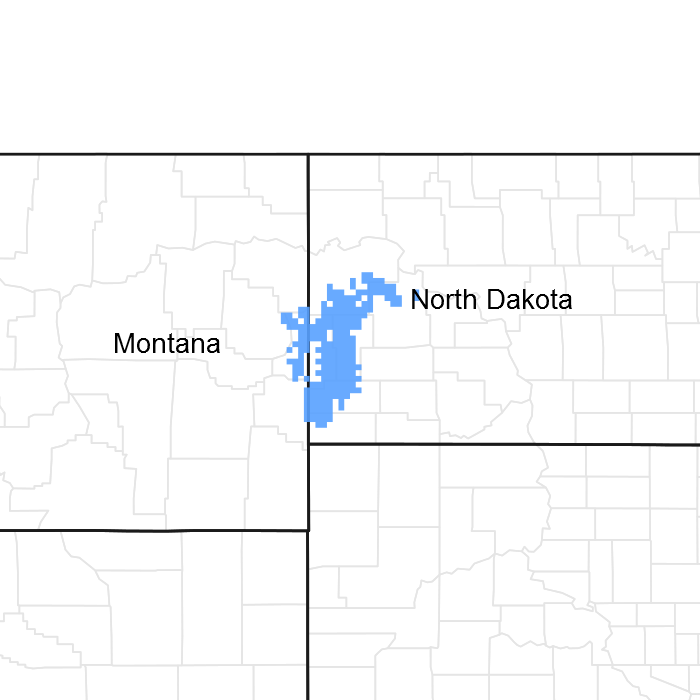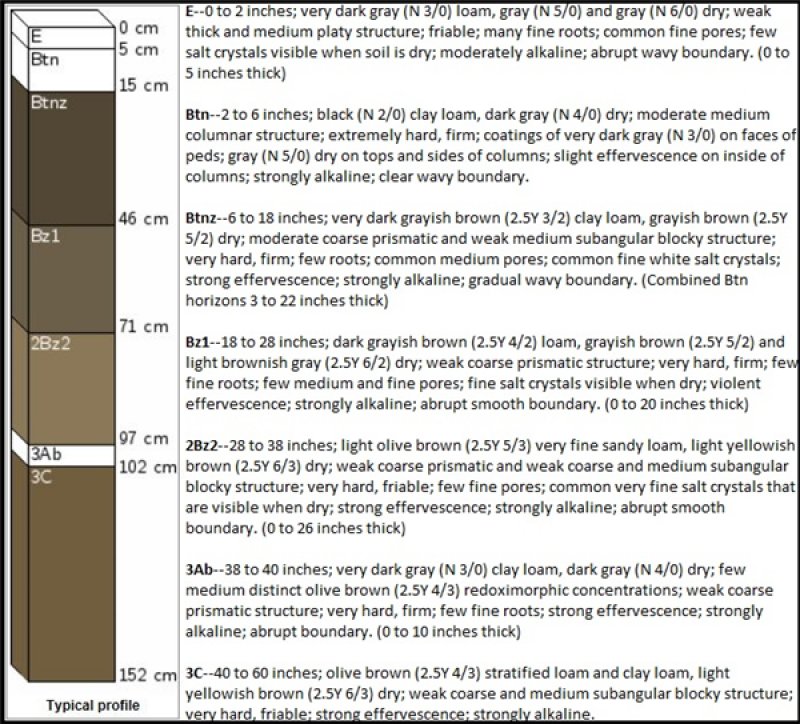
Natural Resources
Conservation Service
Ecological site R058CY090ND
Saline Lowland
Last updated: 10/31/2018
Accessed: 04/14/2025
General information
Provisional. A provisional ecological site description has undergone quality control and quality assurance review. It contains a working state and transition model and enough information to identify the ecological site.

Figure 1. Mapped extent
Areas shown in blue indicate the maximum mapped extent of this ecological site. Other ecological sites likely occur within the highlighted areas. It is also possible for this ecological site to occur outside of highlighted areas if detailed soil survey has not been completed or recently updated.
MLRA notes
Major Land Resource Area (MLRA): 058C–Northern Rolling High Plains, Northeastern Part
MLRA 58C covers 2,780 square miles and encompasses approximately 1.8 million acres. MLRA 58C spans two states with 96 percent of the area in North Dakota and 4 percent in Montana. The acreage inside MLRA 58C is 56 percent privately owned and 44 percent federal land. The federal land consists of the Fort Berthold Indian Reservation, Little Missouri National Grasslands, and Theodore Roosevelt National Park. MLRA 58C landscape is characterized by steeply sloping, dissected badlands along the Little Missouri River and its tributaries. Tertiary marine shale, siltstone, and sandstone sediments are the most common soil parent materials in this MLRA. Primary land uses are rangeland for grazing and wildlife habitat. Microclimates inherent in badlands landscapes influence both variety and abundance of vegetation in MLRA 58C. South- and west-facing exposures are dry, hot, and sparsely vegetated. More humid and cooler north- and east-facing exposures are favorable for abundant forage and woody vegetation.
Classification relationships
Major land resource area (MLRA): 058C-Northern Rolling High Plain Northeastern Part
Ecological site concept
The Saline Lowland site is comprised of alluvial soils in drainageways and on floodplains. This site has soils with high concentrations of salts and sodium. Typically, the soils for this site have carbonates and visible salts or gypsum crystals at depths of 4 to 11 inches, but they can be found throughout the soil profile.
Associated sites
| R058CY092ND |
Wet Meadow Soils on the Wet Meadow ecological site are poorly drained. This site is typically located in drainageways, on low terraces, and in abandoned oxbows. The Wet Meadow site has a seasonal or perennial high water table within 1.5 feet from the surface, with little or no evidence of salts. There are evident redoximorphic features within 6 inches of the soil surface or immediately below the organic soil layer. This site is found upslope from the Wetland ecological site and on the same landform or downslope of the Saline Lowland ecological site. Indicator species include prairie cordgrass, northern reedgrass, and no shrubs. This site has more production, far less western wheatgrass, and far more prairie cordgrass than the Saline Lowland ecological site. |
|---|---|
| R058CY072ND |
Clayey The Clayey ecological site is commonly located adjacent to and upslope from the Saline Lowland site. These are heavy-textured, well drained or moderately well drained soils on upland landforms that do not receive additional moisture from runoff. Soils on Clayey ecological sites are upslope to soils on Saline Lowland ecological sites. Clayey sites are also upslope from Claypan and Thin Claypan ecological sites and are downslope from Shallow Loamy and Shallow Clayey sites. Clayey sites can be on associated landscape positions as Claypan ecological sites. Soils on Clayey sites will form a ribbon greater than 2 inches long due to the high content of clay in these soils. Clayey sites that are influenced by the hydrology and parent materials that formed the soils on adjacent Claypan sites may exhibit some of the characteristics of sodium-affected soils on Claypan sites. Indicator species: dominated by of western wheatgrass and green needlegrass. Clayey sites produce better than Claypan sites with more green needlegrass and western wheatgrass, and less blue grama. |
| R058CY073ND |
Claypan The Claypan ecological site is commonly located adjacent to or in coordination and upslope from Saline Lowland site. These are heavy-textured, well drained or moderately well drained soils on upland landforms that do not receive additional moisture from runoff. Soils on Claypan sites are sodium-affected. Those soils have a dense, root-limiting subsoil layer (called the "claypan") that is of heavy silty clay loam ranging to clay, and will form a ribbon greater than 2 inches long. The heavy-textured, sodium-affected Claypan is typically below 6 inches of the soil surface, and has columnar structure with visible salts and gypsum crystals below 16 inches. Sodium-affected landscapes in MLRA 58C exhibit the shallow microrelief that is evident in the pockmarked appearance of the ground surface. The Saline Lowland site occurs in the drainageways below the Claypan sites that are on the microhighs and Thin Claypan sites are in the microlows. Indicator species are western wheatgrass with an understory of blue grama, heath aster, and western yarrow along with a few shrubs of fringed sagewort and Nuttall’s saltbush. |
| R058CY081ND |
Thin Claypan The Thin Claypan ecological site is commonly located adjacent to or in coordination with the Saline Lowland site. These are heavy-textured, well drained or moderately well drained soils on upland landforms that do not receive additional moisture from runoff. Soils on Thin Claypan sites are severely sodium-affected. They have a dense, root-limiting subsoil (claypan) layer that ranges from heavy silty clay loam to clay, and will form a ribbon greater than 2 inches long. The heavy-textured, sodium-affected claypan is typically within 6 inches of the soil surface and has columnar structure with visible salts and gypsum crystals above 16 inches deep. Sodium-affected landscapes in MLRA 58C exhibit the shallow microrelief that is evident in the pockmarked appearance of the ground surface. The Saline Lowland sites occur in drainageways below the Thin Claypan sites in the microlows and Claypan sites on microhighs. Another soil type is also included with this ecological site: it has all the same traits as the soil list above except the claypan is absent and it has carbonates at or near the soil surface. This included soil formed in slope alluvium on fans from the nearby sparsely-vegetated, very steep, soft, sedimentary bedrock, (i.e. Badlands). The soil is weakly developed with stratified layers of sediments apparent just below the surface layer. Indicator species are western wheatgrass and sandberg bluegrass with an understory of blue grama and buffalograss. Also present are heath aster, cudweed sagewort, and western yarrow, along with a few shrubs of fringed sagewort, cactus, and Gardner's saltbush. |
Table 1. Dominant plant species
| Tree |
Not specified |
|---|---|
| Shrub |
Not specified |
| Herbaceous |
(1) Pascopyrum smithii |
Click on box and path labels to scroll to the respective text.


